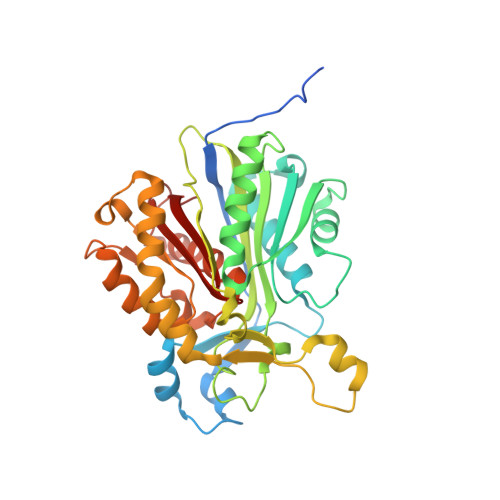Probing the Mechanism of the Mycobacterium tuberculosis beta-Ketoacyl-Acyl Carrier Protein Synthase III mtFabH: Factors Influencing Catalysis And Substrate Specificity.
Brown, A.K., Sridharan, S., Kremer, L., Lindenberg, S., Dover, L.G., Sacchettini, J.C., Besra, G.S.(2005) J Biol Chem 280: 32539-32547
- PubMed: 16040614
- DOI: https://doi.org/10.1074/jbc.M413216200
- Primary Citation of Related Structures:
1M1M, 2AHB, 2AJ9 - PubMed Abstract:
Mycolic acids are the dominant feature of the Mycobacterium tuberculosis cell wall. These alpha-alkyl, beta-hydroxy fatty acids are formed by the condensation of two fatty acids, a long meromycolic acid and a shorter C(24)-C(26) fatty acid. The component fatty acids are produced via a combination of type I and II fatty acid synthases (FAS) with FAS-I products being elongated by FAS-II toward meromycolic acids. The beta-ketoacyl-acyl carrier protein (ACP) synthase III encoded by mtfabH (mtFabH) links FAS-I and FAS-II, catalyzing the condensation of FAS-I-derived acyl-CoAs with malonyl-acyl carrier protein (ACP). The acyl-CoA chain length specificity of mtFabH was assessed in vitro; the enzyme extended longer, physiologically relevant acyl-CoA primers when paired with AcpM, its natural partner, than with Escherichia coli ACP. The ability of the enzyme to use E. coli ACP suggests that a similar mode of binding is likely with both ACPs, yet it is clear that unique factors inherent to AcpM modulate the substrate specificity of mtFabH. Mutation of proposed key mtFabH residues was used to define their catalytic roles. Substitution of supposed acyl-CoA binding residues reduced transacylation, with double substitutions totally abrogating activity. Mutation of Arg(46) revealed its more critical role in malonyl-AcpM decarboxylation than in the acyl-CoA binding role. Interestingly, this effect was suppressed intragenically by Arg(161) --> Ala substitution. Our structural studies suggested that His(258), previously implicated in malonyl-ACP decarboxylation, also acts as an anchor point for a network of water molecules that we propose promotes deprotonation and transacylation of Cys(122).
Organizational Affiliation:
School of Cellular and Molecular Biosciences, University of Newcastle upon Tyne, UK.














